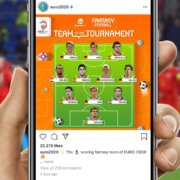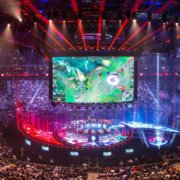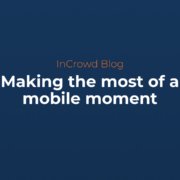Why sponsorship has the potential to be stronger than ever
I read a fascinating article recently by Michael Broughton titled ‘Sponsorship is burning’. It highlighted the recent growth in digital media, specifically programmatic advertising, and how this growth threatens the sponsorship share of advertiser’s budgets from which rightsholders have historically benefitted.
The question posed, is that given programmatic advertising can target the right person, at the right place, at the right time…why on earth would you do anything else? Why spend money on sponsorship which is often expensive and cannot accurately track the subsequent benefits, when you can run a programmatic campaign and track every penny of revenue?
It is a very real question, and one that is currently being posed to rightsholders from potential sponsors, and ultimately having a dramatic effect on the market.
However, through the doom and gloom, there are 2 key reasons why sponsorship has the potential to be a stronger proposition than ever before, in today’s ever evolving and complex world. But as Misha Ser wrote recently in ‘Sport asleep at the wheel’, rightsholders need to ‘evolve’, and in this piece, I discuss why I feel rightsholders should begin to view themselves as both creative agencies, and media owners in the face of the rise of programmatic advertising.
-
Brands need compelling content ideas now more than ever
‘Content is king’ is probably one of the most used statements in the last year or so in the marketing industry, but is obviously a relevant one. With consumers now seeing on average 5,000 adverts a day, brands need a way to stand out from the crowded market place, and communicate with their target audience. It is often the job of creative agencies to come up with ideas that create that emotional bond with the consumer, and media agencies to then to deliver the message to that audience in the right environment. However, given the sheer amount of content now available through social media, websites and elsewhere, delivering that compelling brand message is becoming increasingly difficult. Take the recent McDonalds ‘Fillet-o-Fish’ campaign disaster as an example, where, if nothing else, it highlighted the extent a creative agency went to create a story that would resonate with the audience. It failed, on a quite spectacular scale, and I imagine at quite a cost.
This is where sponsorship still has its unique position. At a cost, arguably comparable to the work of a creative agency, it helps provide brands an identity to align with, ideas for inspiring content, a platform to share their brand message, and a credibility that will attract consumers. In a world where data and research influences every penny of marketing spend, the fact that 64% of people would rather buy from a brand that sponsors their sport, than one that doesn’t, highlights sponsorships unique offering (PSG Sponsorship). Sport generates a passion in humans that is rarely matched, and brands can tap into that in a natural and meaningful way.
I remember everything from the first ever Southampton FC game I attended at the Dell as a 6-year-old. I remember the soundtrack the players ran out too. I remember the smell. I remember the chants. And yes, I remember the Sanderson shirt logo, the Carling Premiership branding and the Draper Tools signage around the scoreboard. Why? Those brands stuck into my mind because of the sheer passion I had for Matt Le Tissier et al. Content therefore, ranging from fans unique experiences, to the epic, emotional battles on the pitch, provide brands with ammo to align their overarching message with.
This is something programmatic simply cannot do.
Programmatic is not a magic wand that can magically generate results, which is often the perception. The hard graft (and cost) of creating a brand identity remains.
However, back then, the 6-year-old me was clearly not in any need of power tools for example, and therefore you could argue that the Draper Tools sponsorship was wasted on me. And of course, it was, back then at least. But a prime target for power tools would have been my Dad, who as well as being a devout Southampton fan, also regularly did DIY work in the garden and around the house. Therefore, if there was a way back in 1996, for Draper Tools to subsequently translate his passion for Southampton FC and need for power tools into direct, trackable revenue, in a targeted and efficient way…then I’m sure they would have jumped at the opportunity.
This is what programmatic can do.
Surely then, rightsholders should be thrilled that their partners, have a way of further translating the benefits of sponsorship into trackable revenue, in the same way a creative agency would be thrilled if a media agency translated their work into a successful, profitable campaign. And in that sense, rightsholders should begin to view themselves as creative agencies, providing brands with ideas, stories, and an identity, which can then be amplified through programmatic and other channels. The fact that the activation-to-fee ratio has passed two to one for the first time ever, and that 98% of brands use social media to further activate their sponsorship, highlight this is happening, which was not the case back in 1996. (IEG)
This philosophy alone, however, assumes that money grows on trees, and that brands can afford to not only spend a chunk on sponsorship, but also spend a further amount activating through other channels to ensure revenue from that sponsorship is driven. Michael Broughton in his article is actually a big advocate of sponsorship, but questions how rightsholders will fare when brands are allocating budgets.
And that is why, it is crucial, that rightsholders also begin to see themselves as media owners.
-
Brands demand a ROI
Put simply, the days of impressions are dead.
It’s a worthless metric.
Not only in sponsorship, but in the advertising industry as a whole. Brands are now under incredible pressure from board room level to deliver results from every penny of marketing spend. As a result, post campaign presentations no longer focus on impressions, reach, or even clicks. It’s all about that headline number. Test drives. Hotel bookings. Bets placed…Revenue.
This of course, is where programmatic has thrived, and forced the channels of print, TV, and even social media to think hard about how they service this requirement.
Sponsorship, and specifically rightsholders are now very much now in the same situation. IEG research highlights this, by showing that assistance measuring ROI was the most desired service expected from a rightsholder. Thus, in the same way that traditional print media owners have had to evolve from print to digital, to then working with data management platforms (DMP), simply to survive…rightsholders also need to act. They need to think like media owners.
A logo on the front of a team’s shirt, in isolation, is no longer enough. Don’t let the short termism of Chinese betting brands or Premier League sleeve sponsorships this summer cloud that statement…rightsholders need to prove to brands that they can drive trackable ROI from the partnership, otherwise, as Phil Stephan from Two Circles suggested in his blog, “they risk being left behind”. In today’s world, that means being digital first. The 2017 report ‘What sponsors want and where the dollars will go’ summed up these challenges well when explaining that sponsorship spend may have dipped due to “a lingering gap between sponsor expectations and properties’ ability to deliver when it comes to both personalised marketing opportunities based on data, and valuable digital content and platforms”.
Rightsholders have the huge advantage, that they have substantial, passionate fanbases waiting to be unlocked. Listening to Gareth Balch, CEO of Two Circles, recently was fascinating. He explained that his message to their clients, is that there is a treasure chest of fan data, just waiting to be opened to the rightsholders benefit. As Two Circles are proving, this is true, and they are helping rightsholders drive revenue using data through ticketing, retail and sponsorship. In a similar vein, rightsholders should also be confident that they have another valuable treasure chest, which they can offer to their sponsors.
As the latest Nielsen report points, “the smartest rightsholders are already using their in-depth knowledge of their fan base to ensure brand partners are activating in the most effective way. The smartest brands are already demanding such information from their sponsorship property”. It’s only a matter of time before the majority wake up, and if rightsholders begin to show to brands, that through a fan focused, owned digital platform, they can clearly drive a trackable ROI from sponsorship spend…then I feel rightsholders will have gone some way towards protecting themselves from programmatic cannibalising brands budgets.
Obviously, this is where I begin to talk about InCrowd’s work in this area. For another time…
In summary, yes, it might sound weird to describe rightsholders as both creative agencies and media owners, because of course they are not. Rightsholders are unique and powerful in their own way. However, by thinking, and learning from how those organisations work with brands in today’s complex world, then rightsholders will ensure that sponsorship has never been a stronger proposition for brands.










